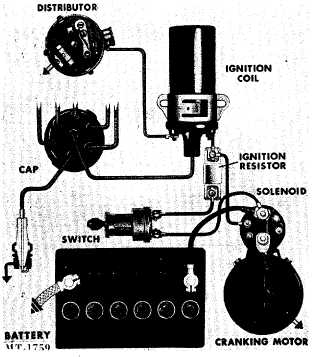|
| |
TRUCK SERVICE MANUAL
TM 5-4210-230-14&P-1
ELECTRICAL
Fig. 4 Schematic Diagram of Primary and Secondary Circuits
of 12-Volt Ignition System
obtain
greatly
improved
starting
performance
at
low
temperatures, the resistor is bypassed during cranking,
thereby connecting ignition coil directly to battery. This
makes full battery voltage available to coil and, thus, keeps
ignition voltage as high as possible during cranking. The
bypassing of ignition resistor during cranking is accomplished
by use of a "finger" within the solenoid which is connected to
the ignition coil. As solenoid contacts close, the ignition coil is
connected to battery through the solenoid "finger". To prevent
the engine from firing while making underhood cranking tests
on trucks using 12-volt system, ground distributor primary
lead.
COIL POLARITY
One of the major causes for hard starting or spark plug
misfiring under load results when the ignition coil lead wire to
the distributor is installed on the wrong side of the coil. This
condition causes reversed coil polarity.
Voltage at the spark plug terminals should always be
negative. Whether it is or not depends on how the primary
leads are attached to the coil. Remember, primary lead hook-
up directly affects coil polarity, which in turn determines
whether voltage at the spark plug terminals is negative or
positive. On IH trucks the distributor wire to the coil should
always be placed on the negative side of the coil if the
electrical system is negative grounded, or on
the positive side if the electrical system is positive grounded.
If the primary leads are incorrectly attached, the direction of
current flow through the coil is reversed. Consequently, coil
polarity is reversed, resulting in positive voltage being
supplied to the spark plug terminals.
What difference does it make whether positive or
negative voltage is supplied to the spark plug terminals?. It
directly affects the amount of voltage required to fire the spark
plugs. When polarity at the spark plug terminals is positive,
it's harder for the voltage to jump across the air gap than
when polarity at the plug terminal is negative. Just why this is
so is related to a pair of electrical theories--the electron theory
and the theory of thermionic emission.
According to the electron theory, all current flows from
negative to positive. The theory of thermionic emission states
essentially it's easier for electrons to leave a hot surface than
a cold surface.
Combining the two theories, one finds that electrons
will always leave a negative charged surface for a positive
charged surface, and they will leave the negatively charged
surface with more ease when the surface is heated.
Spark plug design is such that the center electrode
almost always operates at a higher temperature than the
ground electrode. Since it's easier for electrons to leave a hot
surface, it is preferred to have the electrons "jump" from the
hotter center electrode to the cooler ground electrode.
When the center electrode is negatively charged
(negative voltage at the spark plug terminals), this is what
happens. Stated another way, putting the negative charge on
the hotter center electrode causes the gap to be ionized at
lower voltage. (Ionization is necessary to permit passage of
the spark through the high resistance of the gases in the
cylinder.)
When positive voltage is supplied to the plug terminals,
which happens when coil polarity is accidentally reversed, the
hotter
center
electrode
becomes
positive
charged.
Consequently, electrons must leave the negative charged
ground electrode and move to the positive charged center
electrode. But, since the ground electrode is cooler than the
center electrode (and remember, it's easier for the electrons to
leave a hotter surface), it takes more voltage to make the
current jump the gap-in fact, up to 45 percent more. See Fig.
5.
CTS-2013-E Page 5
PRINTED IN UNITED STATES OF AMERICA
|

